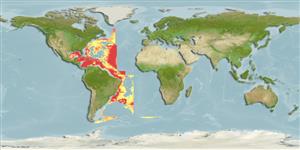Classificação / Names
Nomes comuns | Sinônimos | Catalog of Fishes(Gênero, Espécies) | ITIS | CoL | WoRMS | Cloffa
>
Ophidiiformes (Cusk eels) >
Ophidiidae (Cusk-eels) > Neobythitinae
Etymology: Bassozetus: Latin, bassus = thick, fat + Greek, ketos = marine mosnter, whale (Ref. 45335).
More on author: Gill.
Environment: milieu / climate zone / depth range / distribution range
Ecologia
marinhas batidemersal; intervalo de profundidade 1760 - 5062 m (Ref. 84269), usually 1760 - 3875 m (Ref. 84269). Deep-water
Atlantic.
Tamanho / Peso / Idade
Maturity: Lm ? range ? - ? cm
Max length : 32.9 cm TL macho/indeterminado; (Ref. 41039)
Descrição suscinta
Chaves de identificação | Morfologia | Morfometria
Snout inflated; eyes much smaller than snout; opercular spine weak or absent; preopercle without spines and posteriorly expanded almost reaching posterior margin of opercle; pseudobranchial filaments 2 (Ref. 34024).
Almost exclusive inhabitant of the continental rise, but also caught from lower slope to abyssal depths (Ref. 84269). Uncommon species (Ref. 34024). Oviparous, with oval pelagic eggs floating in a gelatinous mass (Ref. 205).
Ciclo de vida ou comportamento de acasalamento
Maturities | Reprodução | Spawnings | Egg(s) | Fecundities | Larvas
Nielsen, J.G., D.M. Cohen, D.F. Markle and C.R. Robins, 1999. Ophidiiform fishes of the world (Order Ophidiiformes). An annotated and illustrated catalogue of pearlfishes, cusk-eels, brotulas and other ophidiiform fishes known to date. FAO Fish. Synop. 125(18):178p. Rome: FAO. (Ref. 34024)
Status na Lista Vermelha da UICN (Ref. 130435)
Ameaça para os humanos
Harmless
Uso pelos humanos
Pescarias: sem interesse
Ferramentas
Relatórios especiais
Baixar XML
Fontes da internet
Estimates based on models
Preferred temperature (Ref.
123201): 2.1 - 4.3, mean 2.7 °C (based on 1920 cells).
Índice de diversidade filogenética (Ref.
82804): PD
50 = 0.5001 [Uniqueness, from 0.5 = low to 2.0 = high].
Bayesian length-weight: a=0.01000 (0.00244 - 0.04107), b=3.04 (2.81 - 3.27), in cm total length, based on all LWR estimates for this body shape (Ref.
93245).
Nível Trófico (Ref.
69278): 3.6 ±0.6 se; based on size and trophs of closest relatives
Resiliência (Ref.
120179): Elevada, tempo mínimo de duplicação da população menor que 15 meses (Preliminary K or Fecundity.).
Fishing Vulnerability (Ref.
59153): Low vulnerability (23 of 100).
